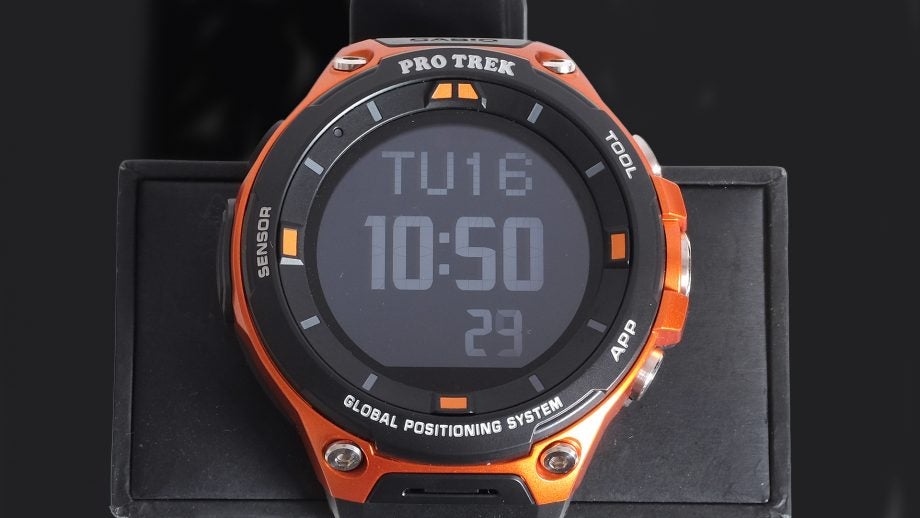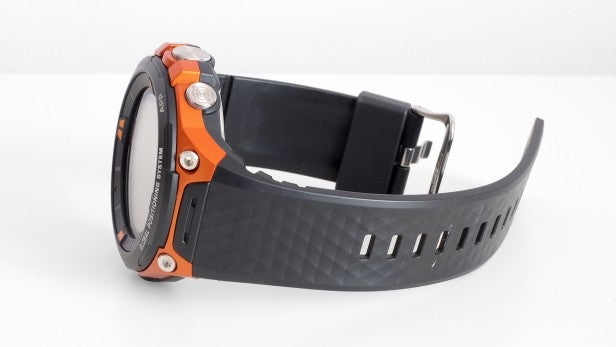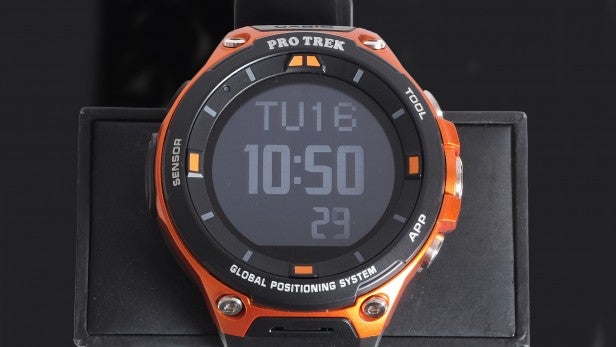Casio Pro Trek Smart WSD-F20 Review
Casio Pro Trek Smart WSD-F20 Review
An Android Wear watch for hikers

Sections
- Page 1 Casio Pro Trek Smart WSD-F20 Review
- Page 2 Fitness Tracking Review
- Page 3 Software, Battery Life and Verdict Review
Verdict
Pros
- Plenty of sensors
- Great hiking features
- Versatile two-layer screen
Cons
- A bit bulky
- Typical Android Wear battery life
- Low-end CPU
Key Specifications
- Review Price: £450.00
- Android Wear 2.0
- Dual-core 1GHz Cortex-A7 CPU
- GPS
- Wi-Fi
- Magnetometer
- Barometer
What is the Casio Pro Trek Smart WSD-F20?
The Casio WSD-F20 is a watch made for active people. It looks more like a top-end runner’s watch, rejecting the style-obsessed blueprint of the majority of smartwatches.
But this isn’t an everyday sport watch, because it runs Android Wear. It’s Casio’s second Android Wear watch, following the WSD-F10.
This new version doesn’t radically improve battery life but it does add GPS, making it a much better tracker of outdoor activities. However, serious athletes may still prefer the Garmin Forerunner 935 or Fenix 5X, thanks to superior battery life – even if they have less smartwatch credibility.

Casio WSD-F20 – Design and Display
The Casio WSD-F20 wears its size as if to prove its serious sports watch status. Although it isn’t distinctly thicker than some more normal-looking Wear watches, its face is oversized and the bezel super-chunky.
Related: Best smartwatch
Like a true dedicated sports watch, however, its bulk makes it easier to fit in proper ruggedisation. As well as having a screen recessed beneath its surround – which makes smashing the glass far less likely – the Casio WSD-F20 has been tested against the MIL-STD-810G standard. This encompasses a whole series of ‘military-grade’ conditions for temperature, pressure, shock impact and more.

Probably the most important offering is water resistance. The Casio WSD-F20 is water-resistant up to 50 metres, or five atmospheres of pressure. It sounds impressive, but as a result of the added pressure caused by your movement, this actually only equates to “swim-proofing”. Digging deeper into Casio’s documentation, diving and windsurfing aren’t recommended while wearing this watch.
It’s a shame, but this isn’t the main premise of such a watch – nor alternatives such as the Garmin Fenix 5. I find the Casio WSD-F20 less comfortable than the Fenix 3, but this is largely a result of the latter’s more flexible, better-ventilated strap. There isn’t too much in it as – despite the bulk – this watch isn’t uncomfortably heavy.

The Casio WSD-F20 does feel pretty solid, although not quite as overtly as some of Garmin’s best. While the inner frame of the watch is stainless steel, the outer parts of the shell are plastic.
The screen is covered with “mineral glass”, which isn’t as hard as Sapphire. However, thanks to the chunky raised bezel, I can see trouble only if the face lands directly on a rock. That’s would be bad news no matter what the coating, though. The glass also has an amusingly dubbed “anti-fouling” coating, designed to repel finger marks and other stains.

This watch looks the part, although I do much prefer the sober design of the Garmin Fenix 5. All that bright white text around the bezel is a bit much, particularly when you should be able to memorise the functions of the three buttons without too much effort.
All three buttons sit on the right side of the watch. One is the standard Android Wear button, flicking between the apps menu and watch face. The top one launches the ‘Tool’ part of the Casio WSD-F20, offering such functionality as a compass. The bottom button launches the main location-tracking app. We’ll deal with these parts in more detail on the next page.

First let’s tackle the screen, which is one of the more interesting parts of the Casio WSD-F20. It’s a circular display aside from a small, inoffensive cut-out at the bottom; it uses a two-layer LCD panel.
When used normally, you see a standard 1.32-inch colour LCD screen of 320 x 300 pixels. It’s reasonably sharp, lacking the slight fuzziness you get with OLEDs that aren’t particularly pixel dense. However, outdoors, visibility isn’t as good as the Samsung Gear S3’s bright OLED display or the Garmin Fenix 5’s screen, which feeds off ambient light.

With one of the simpler watch faces, the Casio WSD-F20 switches to a non-backlit monochrome second layer when not in use, which helps to save battery. This layer is transflective, made clearer on a sunny day rather than diminished by it.
The watch also has a watch-only Timepiece mode that extends the battery from a day or so to a month. It’s handy if all you’ll want is a watch some of the time – and it also gets rid of any outdoors visibility issues since it just uses the secondary display layer.
Display quality isn’t jaw-dropping, with a slight recessed look to the main display layer, but the duo-personality style makes up for this.


